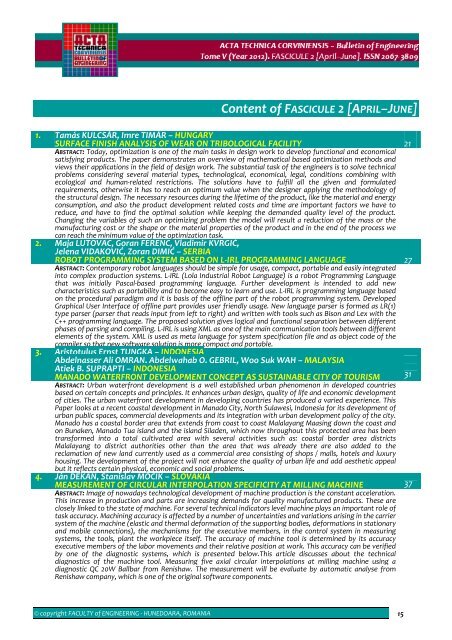Editorial & Advisory Board - Acta Technica Corviniensis
Editorial & Advisory Board - Acta Technica Corviniensis
Editorial & Advisory Board - Acta Technica Corviniensis
You also want an ePaper? Increase the reach of your titles
YUMPU automatically turns print PDFs into web optimized ePapers that Google loves.
Content of FASCICULE 2 [APRIL–JUNE]<br />
1. Tamás KULCSÁR, Imre TIMÁR – HUNGARY<br />
SURFACE FINISH ANALYSIS OF WEAR ON TRIBOLOGICAL FACILITY 21<br />
ABSTRACT: Today, optimization is one of the main tasks in design work to develop functional and economical<br />
satisfying products. The paper demonstrates an overview of mathematical based optimization methods and<br />
views their applications in the field of design work. The substantial task of the engineers is to solve technical<br />
problems considering several material types, technological, economical, legal, conditions combining with<br />
ecological and human‐related restrictions. The solutions have to fulfill all the given and formulated<br />
requirements, otherwise it has to reach an optimum value when the designer applying the methodology of<br />
the structural design. The necessary resources during the lifetime of the product, like the material and energy<br />
consumption, and also the product development related costs and time are important factors we have to<br />
reduce, and have to find the optimal solution while keeping the demanded quality level of the product.<br />
Changing the variables of such an optimizing problem the model will result a reduction of the mass or the<br />
manufacturing cost or the shape or the material properties of the product and in the end of the process we<br />
can reach the minimum value of the optimization task.<br />
2. Maja LUTOVAC, Goran FERENC, Vladimir KVRGIĆ,<br />
Jelena VIDAKOVIĆ, Zoran DIMIĆ – SERBIA<br />
ROBOT PROGRAMMING SYSTEM BASED ON L‐IRL PROGRAMMING LANGUAGE 27<br />
ABSTRACT: Contemporary robot languages should be simple for usage, compact, portable and easily integrated<br />
into complex production systems. L‐IRL (Lola Industrial Robot Language) is a robot Programming Language<br />
that was initially Pascal‐based programming language. Further development is intended to add new<br />
characteristics such as portability and to become easy to learn and use. L‐IRL is programming language based<br />
on the procedural paradigm and it is basis of the offline part of the robot programming system. Developed<br />
Graphical User Interface of offline part provides user friendly usage. New language parser is formed as LR(1)<br />
type parser (parser that reads input from left to right) and written with tools such as Bison and Lex with the<br />
C++ programming language. The proposed solution gives logical and functional separation between different<br />
phases of parsing and compiling. L‐IRL is using XML as one of the main communication tools between different<br />
elements of the system. XML is used as meta language for system specification file and as object code of the<br />
compiler so that new software solution is more compact and portable.<br />
3. Aristotulus Ernst TUNGKA – INDONESIA<br />
Abdelnasser Ali OMRAN, Abdelwahab O. GEBRIL, Woo Suk WAH – MALAYSIA<br />
Atiek B. SUPRAPTI – INDONESIA<br />
MANADO WATERFRONT DEVELOPMENT CONCEPT AS SUSTAINABLE CITY OF TOURISM 31<br />
ABSTRACT: Urban waterfront development is a well established urban phenomenon in developed countries<br />
based on certain concepts and principles. It enhances urban design, quality of life and economic development<br />
of cities. The urban waterfront development in developing countries has produced a varied experience. This<br />
Paper looks at a recent coastal development in Manado City, North Sulawesi, Indonesia for its development of<br />
urban public spaces, commercial developments and its integration with urban development policy of the city.<br />
Manado has a coastal border area that extends from coast to coast Malalayang Maasing down the coast and<br />
on Bunaken, Manado Tua island and the island Siladen, which now throughout this protected area has been<br />
transformed into a total cultivated area with several activities such as: coastal border area districts<br />
Malalayang to district authorities other than the area that was already there are also added to the<br />
reclamation of new land currently used as a commercial area consisting of shops / malls, hotels and luxury<br />
housing. The development of the project will not enhance the quality of urban life and add aesthetic appeal<br />
but it reflects certain physical, economic and social problems.<br />
4. Ján DEKAN, Stanislav MÔCIK – SLOVAKIA<br />
MEASUREMENT OF CIRCULAR INTERPOLATION SPECIFICITY AT MILLING MACHINE 37<br />
ABSTRACT: Image of nowadays technological development of machine production is the constant acceleration.<br />
This increase in production and parts are increasing demands for quality manufactured products. These are<br />
closely linked to the state of machine. For several technical indicators level machine plays an important role of<br />
task accuracy. Machining accuracy is affected by a number of uncertainties and variations arising in the carrier<br />
system of the machine (elastic and thermal deformation of the supporting bodies, deformations in stationary<br />
and mobile connections), the mechanisms for the executive members, in the control system in measuring<br />
systems, the tools, plant the workpiece itself. The accuracy of machine tool is determined by its accuracy<br />
executive members of the labor movements and their relative position at work. This accuracy can be verified<br />
by one of the diagnostic systems, which is presented below.This article discusses about the technical<br />
diagnostics of the machine tool. Measuring five axial circular interpolations at milling machine using a<br />
diagnostic QC 20W Ballbar from Renishaw. The measurement will be evaluate by automatic analyse from<br />
Renishaw company, which is one of the original software components.<br />
© copyright FACULTY of ENGINEERING ‐ HUNEDOARA, ROMANIA 15

















